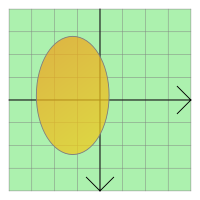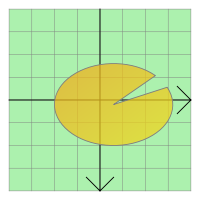QGraphicsEllipseItem Class Reference |
 |  |
To set the item's ellipse, pass a QRectF to QGraphicsEllipseItem's constructor, or call setRect(). The rect() function returns the current ellipse geometry.
QGraphicsEllipseItem uses the rect and the pen width to provide a reasonable implementation of boundingRect(), shape(), and contains(). The paint() function draws the ellipse using the item's associated pen and brush, which you can set by calling setPen() and setBrush().
See also QGraphicsPathItem, QGraphicsRectItem, QGraphicsPolygonItem, QGraphicsTextItem, QGraphicsLineItem, QGraphicsPixmapItem, and The Graphics View Framework.
Member Function Documentation
QGraphicsEllipseItem::QGraphicsEllipseItem ( QGraphicsItem * parent = 0 )
Constructs a QGraphicsEllipseItem. parent is passed to QAbstractGraphicsShapeItem's constructor.
See also QGraphicsScene::addItem().
QGraphicsEllipseItem::QGraphicsEllipseItem ( const QRectF & rect, QGraphicsItem * parent = 0 )
Constructs a QGraphicsEllipseItem using rect as the default rectangle. parent is passed to QAbstractGraphicsShapeItem's constructor.
See also QGraphicsScene::addItem().
QGraphicsEllipseItem::QGraphicsEllipseItem ( qreal x, qreal y, qreal width, qreal height, QGraphicsItem * parent = 0 )
Constructs a QGraphicsEllipseItem using the rectangle defined by (x, y) and the given width and height, as the default rectangle. parent is passed to QAbstractGraphicsShapeItem's constructor.
This function was introduced in Qt 4.3.
See also QGraphicsScene::addItem().
QGraphicsEllipseItem::~QGraphicsEllipseItem ()
Destroys the QGraphicsEllipseItem.
QRectF QGraphicsEllipseItem::rect () const
Returns the item's ellipse geometry as a QRectF.
See also setRect() and QPainter::drawEllipse().
void QGraphicsEllipseItem::setRect ( const QRectF & rect )
Sets the item's ellipse geometry to rect. The rectangle's left edge defines the left edge of the ellipse, and the rectangle's top edge describes the top of the ellipse. The height and width of the rectangle describe the height and width of the ellipse.
See also rect() and QPainter::drawEllipse().
void QGraphicsEllipseItem::setRect ( qreal x, qreal y, qreal width, qreal height )
This is an overloaded member function, provided for convenience.
Sets the item's rectangle to the rectangle defined by (x, y) and the given width and height.
This convenience function is equivalent to calling setRect(QRectF(x, y, width, height))
See also rect().
void QGraphicsEllipseItem::setSpanAngle ( int angle )
Sets the span angle for an ellipse segment to angle, which is in 16ths of a degree. This angle is used together with startAngle() to represent an ellipse segment (a pie). By default, the span angle is 5760 (360 * 16, a full ellipse).
See also spanAngle(), setStartAngle(), and QPainter::drawPie().
void QGraphicsEllipseItem::setStartAngle ( int angle )
Sets the start angle for an ellipse segment to angle, which is in 16ths of a degree. This angle is used together with spanAngle() for representing an ellipse segment (a pie). By default, the start angle is 0.
See also startAngle(), setSpanAngle(), and QPainter::drawPie().
int QGraphicsEllipseItem::spanAngle () const
Returns the span angle of an ellipse segment in 16ths of a degree. This angle is used together with startAngle() for representing an ellipse segment (a pie). By default, this function returns 5760 (360 * 16, a full ellipse).
See also setSpanAngle() and startAngle().
int QGraphicsEllipseItem::startAngle () const
Returns the start angle for an ellipse segment in 16ths of a degree. This angle is used together with spanAngle() for representing an ellipse segment (a pie). By default, the start angle is 0.
See also setStartAngle() and spanAngle().
Best Of
Actualités les plus lues
- Les développeurs détestent-ils les antivirus ? Un programmeur manifeste sa haine envers ces solutions de sécurité 15
- Une nouvelle ère d'IHM 3D pour les automobiles, un concept proposé par Digia et implémenté avec Qt 3
- PySide devient un add-on Qt et rejoint le Qt Project et le modèle d'open gouvernance 1
- Qt Creator 2.5 est sorti en beta, l'EDI supporte maintenant plus de fonctionnalités de C++11 2
- Vingt sociétés montrent leurs décodeurs basés sur Qt au IPTV World Forum, en en exploitant diverses facettes (déclaratif, Web, widgets) 0
- Thread travailleur avec Qt en utilisant les signaux et les slots, un article de Christophe Dumez traduit par Thibaut Cuvelier 1
- « Quelque chose ne va vraiment pas avec les développeurs "modernes" », un développeur à "l'ancienne" critique la multiplication des bibliothèques 94
- Apercevoir la troisième dimension ou l'utilisation multithreadée d'OpenGL dans Qt, un article des Qt Quarterly traduit par Guillaume Belz 0
- Pourquoi les programmeurs sont-ils moins payés que les gestionnaires de programmes ? Manquent-ils de pouvoir de négociation ? 49
- Les développeurs ignorent-ils trop les failles découvertes dans leur code ? Prenez-vous en compte les remarques des autres ? 17
- Les développeurs détestent-ils les antivirus ? Un programmeur manifeste sa haine envers ces solutions de sécurité 16
- Quelles nouveautés de C++11 Visual C++ doit-il rapidement intégrer ? Donnez-nous votre avis 10
- Qt Commercial : Digia organise un webinar gratuit le 27 mars sur la conception d'interfaces utilisateur et d'applications avec le framework 0

- Linus Torvalds : le "C++ est un langage horrible", en justifiant le choix du C pour le système de gestion de version Git 100
- Comment prendre en compte l'utilisateur dans vos applications ? Pour un développeur, « 90 % des utilisateurs sont des idiots » 229
- Quel est LE livre que tout développeur doit lire absolument ? Celui qui vous a le plus marqué et inspiré 96
- Apple cède et s'engage à payer des droits à Nokia, le conflit des brevets entre les deux firmes s'achève 158
- Nokia porte à nouveau plainte contre Apple pour violation de sept nouveaux brevets 158
- Quel est le code dont vous êtes le plus fier ? Pourquoi l'avez-vous écrit ? Et pourquoi vous a-t-il donné autant de satisfaction ? 83
- Le Draft final de la norme C++ 0X validé 181

Le Qt Quarterly au hasard

La reconnaissance des gestes de souris
Communauté
Ressources
- 91 cours et tutoriels Qt
- F.A.Q. Qt : 200 questions et réponses
- 48 Qt Quarterly, 35 Qt Labs et 22 Qt DevNet en français
- 43 outils Qt
- 99 sources Qt et 26 binaires Qt
- 6 livres Qt et 9 critiques
- La documentation de Qt 4.7 en français : 157 classes, 70 concepts et 24 modules
- 3 certifications Qt
Liens utiles
Contact
- Vous souhaitez rejoindre la rédaction ou proposer un tutoriel, une traduction, une question... ? Postez dans le forum Contribuez ou contactez-nous par MP ou par email (voir en bas de page).
Qt dans le magazine
| Cette page est une traduction d'une page de la documentation de Qt, écrite par Nokia Corporation and/or its subsidiary(-ies). Les éventuels problèmes résultant d'une mauvaise traduction ne sont pas imputables à Nokia. | Qt 4.4 | |
| Copyright © 2012 Developpez LLC. Tous droits réservés Developpez LLC. Aucune reproduction, même partielle, ne peut être faite de ce site et de l'ensemble de son contenu : textes, documents et images sans l'autorisation expresse de Developpez LLC. Sinon, vous encourez selon la loi jusqu'à 3 ans de prison et jusqu'à 300 000 E de dommages et intérêts. Cette page est déposée à la SACD. | ||
| Vous avez déniché une erreur ? Un bug ? Une redirection cassée ? Ou tout autre problème, quel qu'il soit ? Ou bien vous désirez participer à ce projet de traduction ? N'hésitez pas à nous contacter ou par MP ! | ||
Copyright © 2000-2012 - www.developpez.com



















